Sailing in general, but especially offshore, can sometimes be a wet experience particularly on a low-freeboard boat like Far Reach, our highly modified Cape Dory 36. So, some kind of protection in the cockpit is helpful to staying dry when the weather turns dirty or the spray starts flying.
The most common solution for protection is to install a full-width dodger which is essentially a wind and spray shield spanning the width of the cockpit. Hard dodgers are sometimes permanently built into the boat and made of wood, fiberglass, or sometimes aluminum. But most often they are fabric stretched over stainless-steel or aluminum tubes.
While the canvas can be removed and the frames folded down, most often they are left up. It is also common to add additional protection including overhead canvas (sometimes with solar panels on still more overhead framing) and all-weather side curtains that can be zipped on or off as the conditions dictate. These elaborate and expensive enclosures provide extensive protection for those in the cockpit (see “Solving the Dodger Dilemma,” Practical Sailor, November 2022).
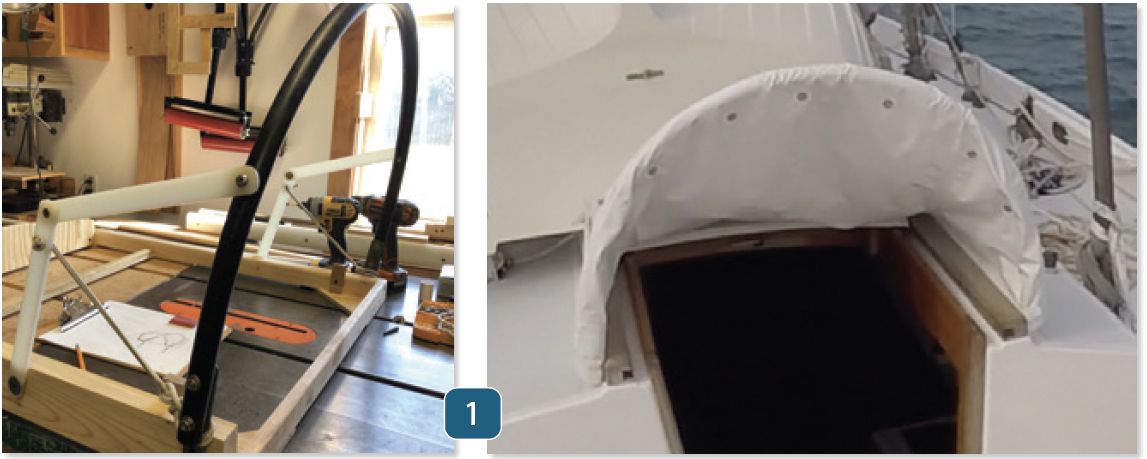
I have always enjoyed the graceful lines of traditional sailboats whether they’re an 1898 pilot cutter, early S&S design such as Dorade or Stormy Weather, or designs influenced by the Cruising Club of America, such as Carl Alberg’s Cape Dory line. Thus, I was easily drawn to the gentle spoon bow, traditional transom and graceful sheer of my own boat, a Cape Dory 36. And while I made many changes to Far Reach during our extensive rebuild (a taller rig, longer bowsprit, raised bulwarks, and stout boom gallows), I wanted to retain her classic lines (see PS November 2022–March 2023).
WHY A PRAM-HOOD?
Very early in the rebuild I decided I did not want a full-width dodger. While I wanted protection over the companionway, especially when the top hatch is slid open, there were several reasons I decided against it. The first is while I saw a few boats with beautifully integrated dodgers (hard and soft) that fit artistically into the overall design of the boat, often they looked like an afterthought focused primarily on the utilitarian function of blocking wind and rain with little regard to the overall aesthetic beauty of sailboat design. To be fair, it is exceedingly difficult to design something as large as a dodger that is both effective and barely noticeable at the same time.
The second reason is that most of the dodgers I saw were quite large and I reasoned they would add significant windage to the front facing profile of the boat. While Far Reach is not a race boat, windage adds drag that can slow down a boat going to windward. Windage can also cause a boat to dance around at anchor and cause it to drag.
I sailed Far Reach essentially engine-free for five years and during that time I had little recourse if the anchor dragged. I could either quickly get a second anchor down or buoy and slip the anchor and sail out of danger. So, keeping windage down was a consideration from the beginning. Many boats out cruising today are not just encumbered by dodger-induced windage but also extensive canvas enclosures, solar arches, wind generators, davits, large inflatables, and additional fuel and water cans strapped along the side decks.
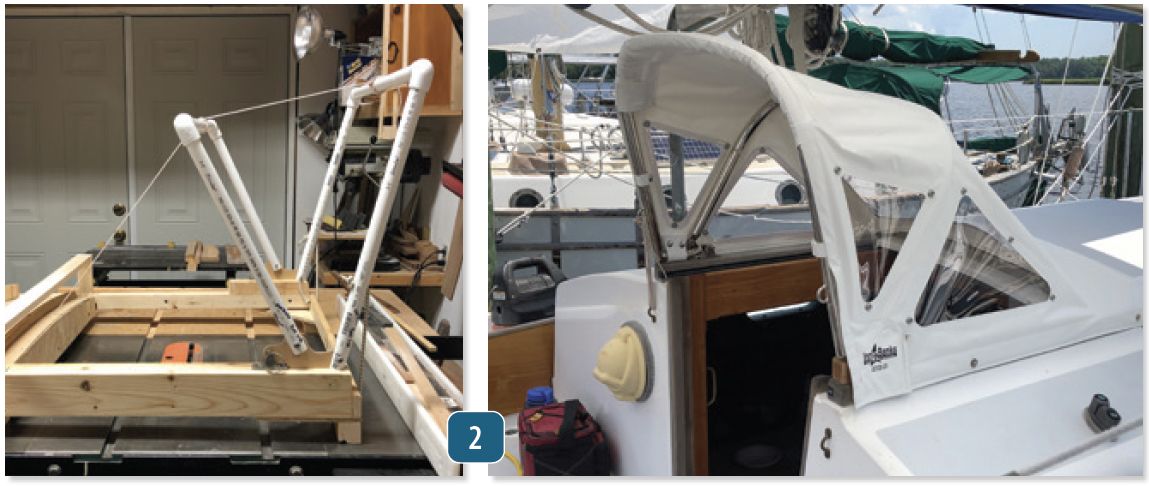
All these accouterments and conveniences add windage to the boat as well make access to the deck more difficult. They can interfere with winches and fairleads, forcing compromises. I wanted to avoid as much of that as possible.
The third consideration is that dodgers and their accessory canvas enclosures can obstruct the crew’s vision of the sails and hinder vision outside the boat, making it harder to see tell-tail signs of wind angles, approaching gusts, nearby boat traffic, and other hazards. Having sailed on a wide variety of boats, small and large, I dislike feeling cocooned in the cockpit and separated from the physical environment, which I relish as part of my sailing experience.
And lastly, large elaborate dodgers, while offering a lot of protection, can be quite expensive. A price of $4,000 to $5,000 is not unreasonable for a quality dodger, not including additional foul-weather enclosures for a boat the size of Far Reach. I have a friend who spent well over $10,000 on a dodger—stainless-steel frame, canvas, and additional foul-weather enclosures.
As I thought about what kind of dodger to choose for Far Reach, I kept returning to pictures I had seen of a simple DIY pram-hood (sometimes called a spray-hood) that Lin Pardey and her late husband Larry used on their famous 29’6” Lyle Hess designed wooden cutter Taleisin.
As I began to research pram-hoods I began to notice there were some beautiful boats using them. Along with Taleisin, another well known and highly successful blue water sailboat using a pram-hood, is the beautiful wooden S&S 40’ sloop Sunstone. She was sailed for more than 30 years all over the world by Tom and Vicky Jackson. I noticed many Swans had pram-hoods over the amidships crew companionway hatch. My friend Kaj Jacobson also built a lovely pram-hood for his gorgeous self-built Hess 34, Astrid (www.knjwoodworking.blogspot.com).
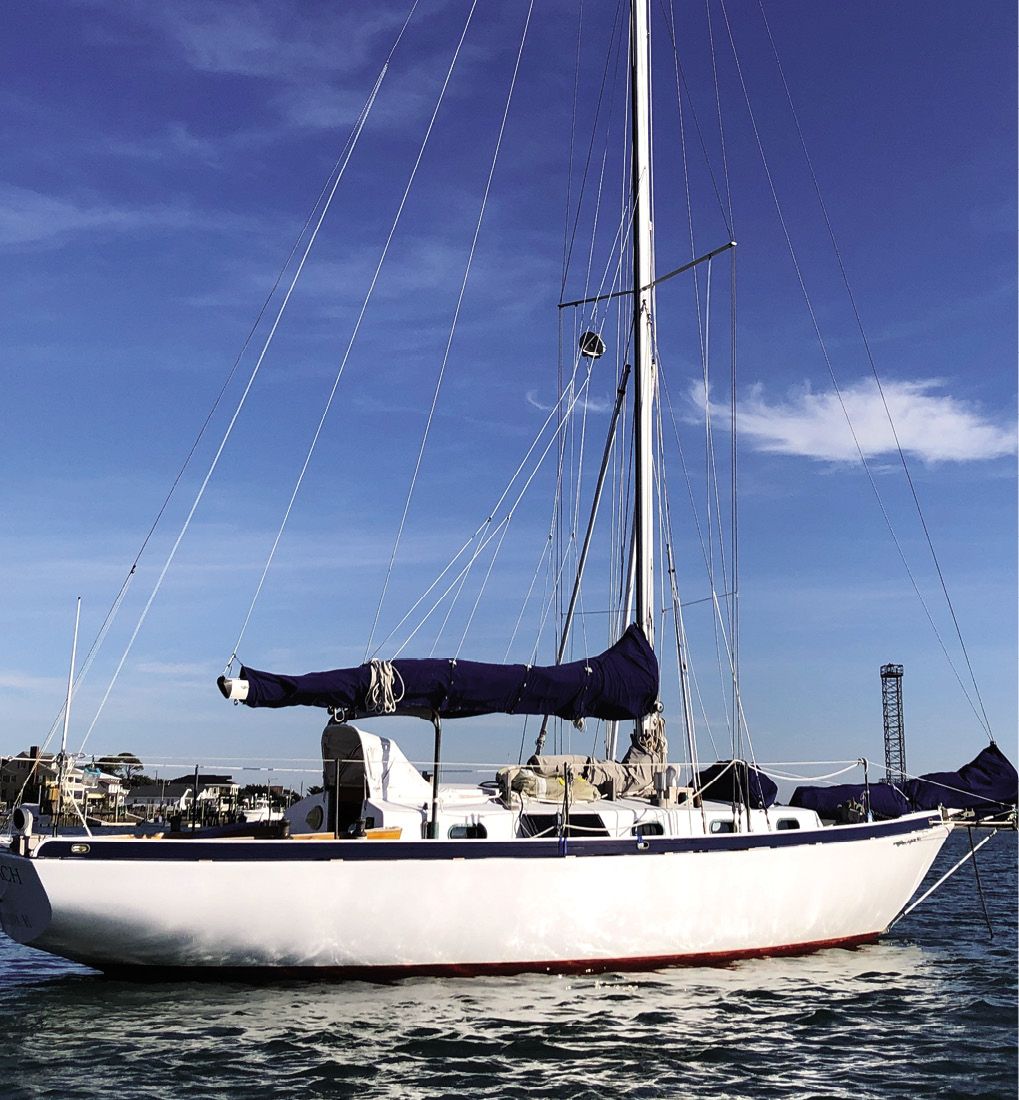
DESIGN CONSIDERATIONS
After careful consideration it was clear we should give the pram hood a try. Pram-hoods typically provide protection strictly for the companionway, their width determined by the size of hatch opening (our pram hood is 30-inches wide). The height is determined by the ergonomics necessary to access the companionway as well as aesthetic considerations. The fabric, stretched over bows (usually two), extends forward over the companionway as well as to the sides.
The pram-hood might be angled aft a bit providing limited protection from side spray or rain being driven into the cockpit from the side or aft. The greatest protection a pram-hood provides is generally from rain or spray coming from forward and abeam, although it provides sun protection to the interior of the boat as well.
Our first pram hood was effective and affordable. We built it based on the Pardey’s design. To get the design right, I corresponded with the Pardeys and they were helpful answering all my questions. The materials included semi-flexible 1-inch diameter black irrigation tubing, brackets made from scrap silicon bronze, ¼-inch thick ultra-high molecular weight strips we purchased from McMaster Carr, some ¼-inch shock cord, and vinyl fabric called Stamoid. It was easy to build and quite effective. Total cost was about $200.
The key was a clever but simple bi-fold hinge system. The hood was low profile. As you entered the companionway, you simply pushed the single bow forward to fold it down a bit, and let it go so the hoop sprang back up over your head.
It was easy to install and remove, and could be stored flat. It was effective keeping the rain and spray out of the companionway. The concave shape on the front side, due to use of a single bow, meant there was not much room under it and the visibility while under the hood was limited since there was no window.
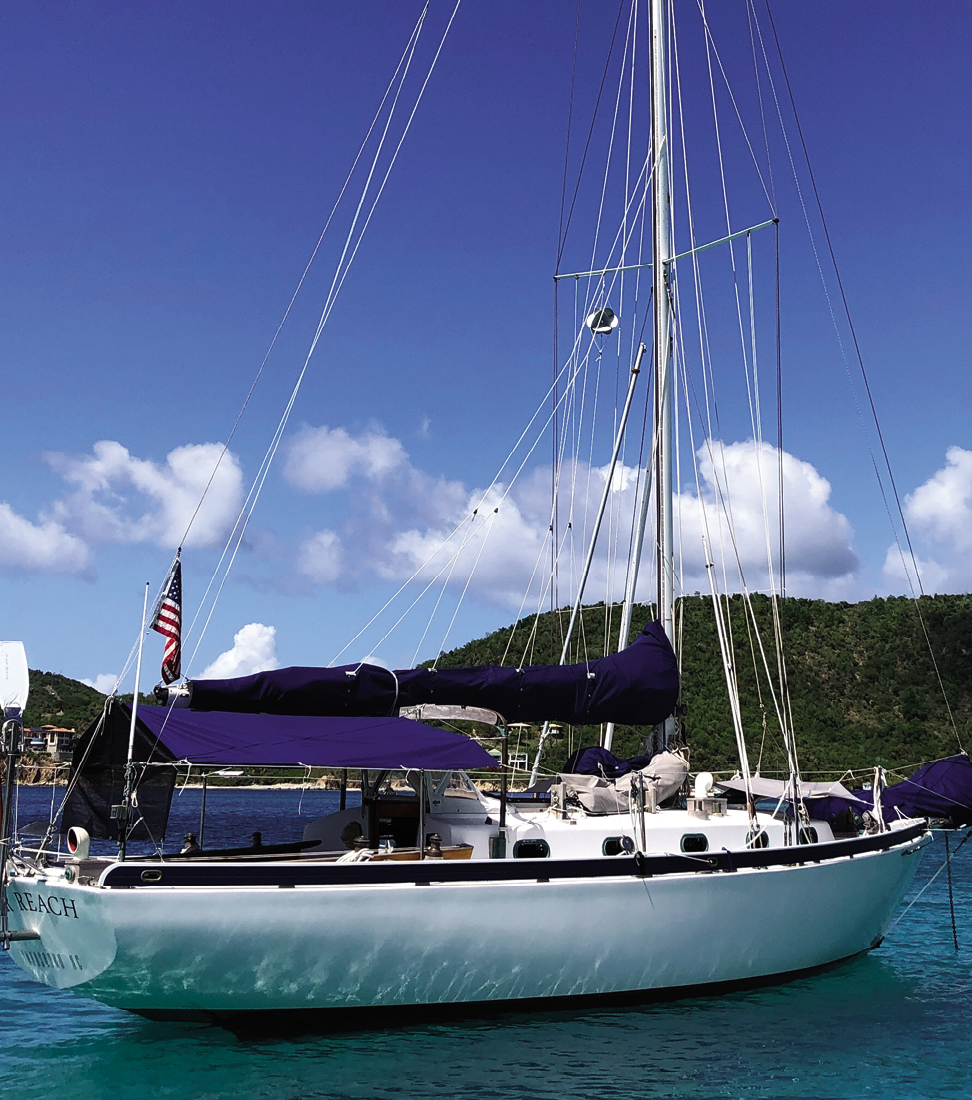
I liked its low profile. Most times you did not notice it was there, so it did not detract from the boat’s clean lines. We sailed with this pram-hood for about five years and 7,000 miles including some rough winter passages to the Virgin Islands from the US East Coast. My experience with this simple system convinced me the continued use of a pram-hood was the way to go.
A MODIFIED PRAM HOOD
In 2020-2021, despite some reluctance on my part, we decided to enter the 20th Century and finally installed a small inboard engine in Far Reach. During that time, I began thinking about modifying the original pram-hood to provide a little more room inside the enclosure and also add a window for improved visibility. I found, especially singlehanding, I spent a lot of time sitting on the bridge deck, legs inside the boat, protected behind the spray hood.
I examined ways to modify our existing hood by adding a second bow. I took it to a trusted canvas shop and they thought it would be difficult to make the kinds of mods I wanted and still make it foldable. Because I liked the pram-hood concept and was generally pleased with our hood, despite its few limitations, I began thinking about a slightly larger more robust foldable design with windows but still easily removable.
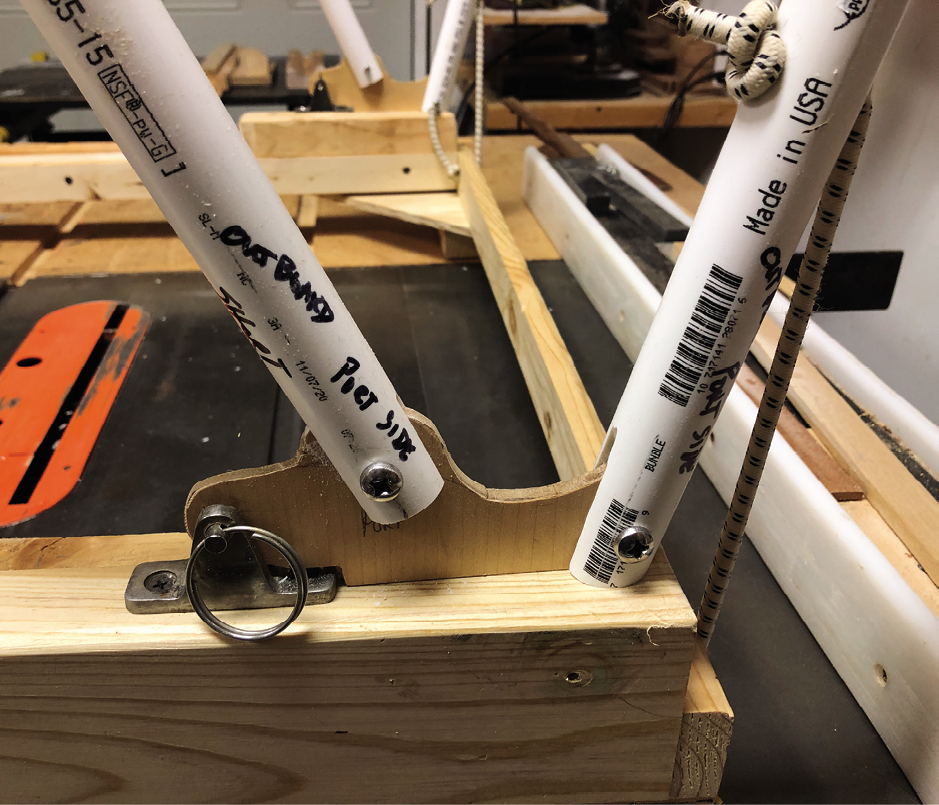
I started the design process by making some sketches of various bows and shapes. Next, I drew out different size hoods on a profile drawing of the boat to see how they looked aesthetically.
I wanted the new hood to be bigger than the original but small enough that it did not draw attention to itself. I wanted the observer’s eye to still be drawn to the boat and not the pram-hood.
One of the limitations we face on Far Reach is the distance between the aft face of the mast and the forward edge of the companionway is 8’6” but our Fatty Knees hard dinghy is 9’ long. Thus, the hard dinghy stowed inverted on chocks between the mast and companionway overlaps the hatch opening a small amount. The overlap necessitated the pram-hood be designed so as to avoid contact with the transom of the dinghy. The hood must pass under the transom yet provide complete rain and spray protection over the companionway.
To make fabrication of the hood easier and to better understand my design requirements, the next step was to make an accurate wood mock-up of our companionway opening. After building the mock-up and carefully confirming the measurements, I used the design drawing to fabricate a simple PVC tube pram-hood frame. I used scraps of plywood to make crude hinges so the hood could fold forward.
I played with the mock frame and made some adjustments till I thought it looked right and worked properly. I then took it to our canvas shop and discussed the design with them. They thought it wouldn’t be too difficult to accommodate the overhanging dinghy transom. They also said if the mock-up was accurate there would be no need to make visits to the boat which would save some money.
They believed they could incorporate a batten as a kind of spreader bar to keep the hood under the transom of the dinghy. They could not, however, bend the SS tubes to the tight radius I wanted for the frame. I was going to have to find a fabricator with the tools and skills to bend the frames to the radius that I wanted.
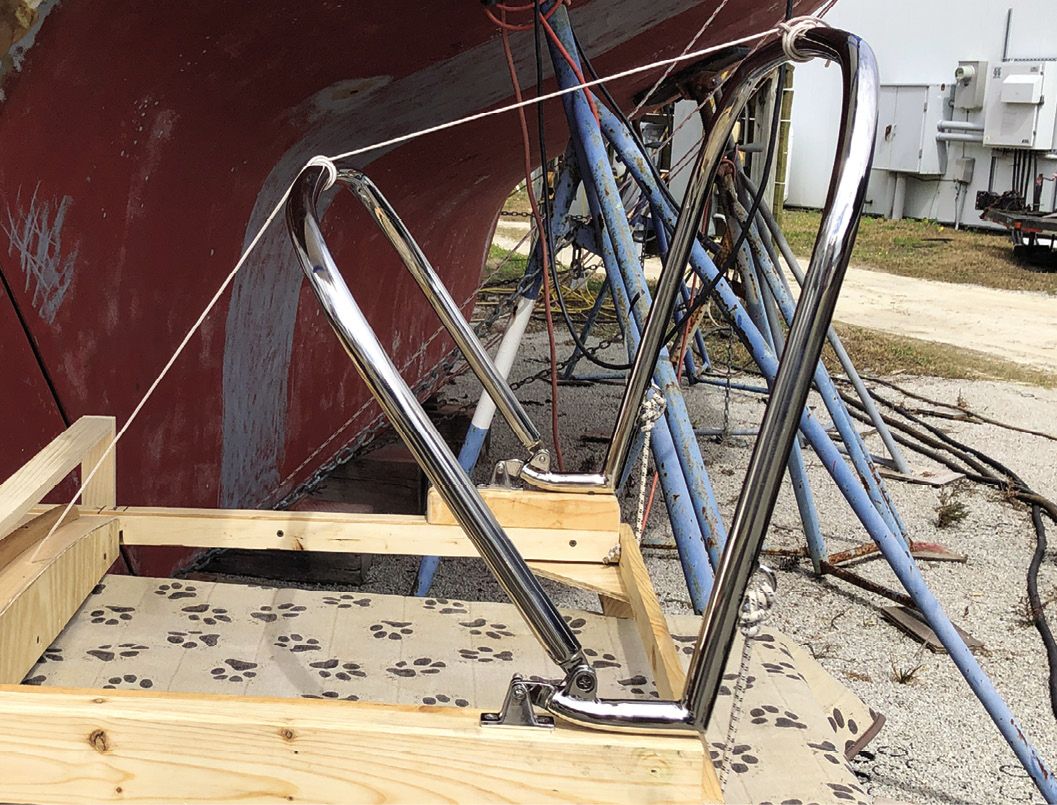
I visited with a SS fabricator who previously had done an excellent job welding a SS bracket on my stove. We discussed the design in detail. I left the mock-up with him along with a detailed drawing. A week later I had a beautifully built 316 SS pram-hood frame. I returned to the canvas shop with the wood mock-up and the SS frame bolted in place. In about a week, the canvas shop had built a cover using white, heavy duty Stamoid fabric which I requested because it is completely water proof, durable, and would blend in with the boat. As discussed, they made the cover with five windows all with snap covers to protect the windows from sun damage.
The new design was easy to secure to the companionway with a single hinge on each side of the hatch rails. I also incorporated the bronze inserts I had previously used to secure the original pram-hood fabric to the sea-hood, which houses the hatch when it is slid forward. I installed a small 30-inch wide PVC bolt-rope sleeve called a Costa track to the aft end of the sea-hood (the hatch slides forward under the sea-hood). The forward end of the fabric slides into the Costa track so that it is locked into place.
I also installed bronze pad eyes on the rear face of the cabin top to secure ¼-inch double-braid line to keep the frame in position but which can be untied to allow it to fold forward. Shock cord could also be used in place of the double braid. The pram-hood fabric and frame can be removed quickly and easily. When removed, the frame folds compactly and is easy to store in the boat.
The hood was easy to install. It fit perfectly. The windows let an exceptional amount of light into the boat via the companionway. The new slightly larger hood permits me to stand on the companionway ladder, with the hatch slid forward, well protected under the pram-hood. I have great visibility except straight forward due to the inverted dinghy but that’s to be expected. At anchor, with the dinghy in the water the visibility forward is superb.
ACCESSORY AWNINGS
Just like sailors who have a full dodger, we incorporated additional canvas to augment the spray/rain protection provided by the pram-hood. The first is a 6’x6’ square grey Sunbrella canvas with grommets around the perimeter. We tie off this awning over the cockpit when sailing to provide sun protection. We can use it sailing upwind or downwind.
The sailing awning takes less than three minutes to erect. There are no battens. We tie the front end to the boom gallows frame and the aft end to the back stay. The sides are tied off with short lanyards to the lifeline with rolling hitches. We can move it to one side or the other as well as position it forward or aft depending on the location of the sun to provide the best shade for the cockpit.
The second awning is a larger piece of blue Sunbrella and matches the color of our sail cover. It’s a trapezoidal shape and is about 9-feet long and 8-feet wide at the front end and about 6-feet wide on the aft end. It completely covers the cockpit. At anchor, installing the larger awning requires that I disconnect the mainsheet block and tackle which I place over the boom gallows along with the coiled mainsheet. When we’re motoring or sailing downwind, the mainsheet is not in the way and we can employ the large or small sun awning without difficulty. Even though it is larger than the 6×6 awning it is faster to put up and take down (about one minute) because we incorporated plastic snaps that hook to the life line.
This sun awning extends forward of the pram hood so we can keep the companionway open in anything but a driving rain blowing from the sides. In addition to protection from the sun and rain we use both these awnings to collect rain water.
We also carry a couple sections of heavy mesh fabric called Cool-A-Roo. Gayle sewed a hem into these mesh rectangles and I installed grommets around the perimeter. We can tie these into our sun awning if we want just that little extra shade for a low angle sunbeam that always seems to find a way past the larger awnings.
DISADVANTAGES
There is no doubt a full-width dodger with or without the additional semi-permanent enclosures would provide more protection than a pram-hood alone. Although we have great protection under the pram-hood, on deck in dirty weather we wear foul weather gear appropriate to the conditions. Our ability to use the additional awnings when sailing is limited to more benign conditions.
ADVANTAGES
The pram-hood style dodger is lower profile. It does not detract from the lines of the boat. The pram-hood has less windage at anchor and while sailing and permits better visibility of the sails, wind, water, and surrounding boat traffic and other hazards like buoys and pilings. A pram-hood does not block the breeze in the cockpit, which is important in warm weather or in the tropics. The pram-hood is easier to remove and stow below deck. A pram-hood, even a high quality one like our current hood, is far less expensive than a full width dodger with enclosures.
Since we installed the new pram-hood I have sailed the boat about 4,000 offshore miles and spent six months living aboard sailing in the Virgin Islands. It has exceeded my expectations. For all the reasons described in this article it is a great alternative to the full dodger many sailors might otherwise view as the only option available.
CONTACTS
SUNBRELLA, www.maldenmills.com
MCMASTER CARR, www.mcmaster.com
STAMOID, www.sergeferrari.com
Two canvas awnings are an important part of how we gain the additional protection from the sun and rain that a small pram-hood would not otherwise provide. But unlike more permanent solutions, these awnings deploy easily, fold flat, and take up little space when stowed. My wife Gayle made ours at home, and I installed the grommets. This keep-it-simple approach gives us protection that can quickly be struck for maximum visibility, which is our first priority.
The “at sea” awning is a 6-by-6 foot grey Sunbrella. The “at anchor” awning is a larger trapezoidal piece of blue Sunbrella about 9-feet long. The forward edge is about eight feet, the stern edge is about and 6-feet long.
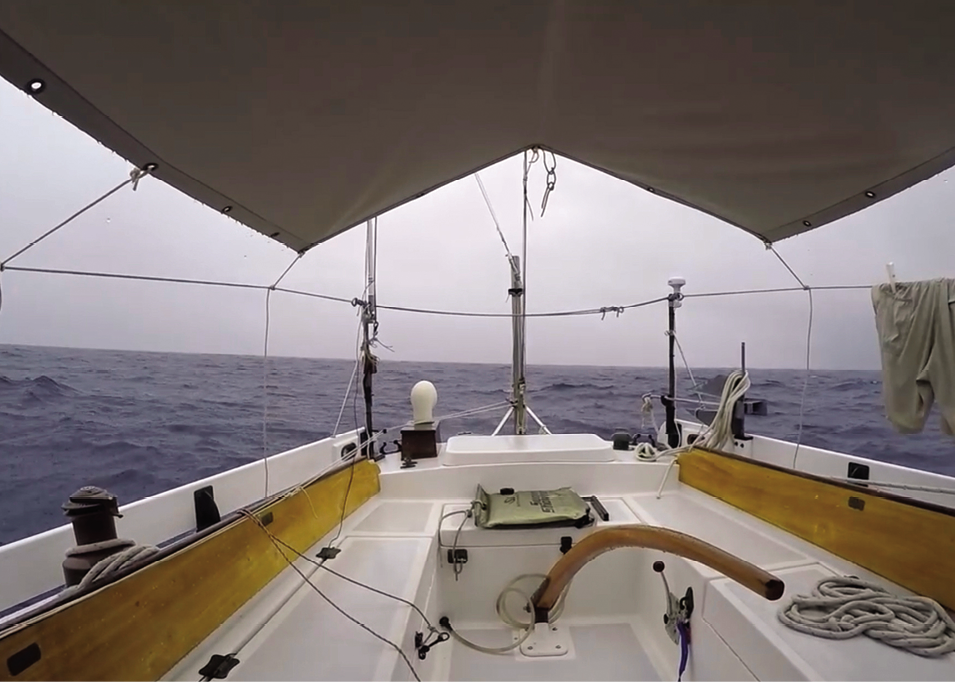
1. Measuring about 6-by-6 feet, the “at sea” cockpit
canvas can be carried in moderate winds.

2. Making sure the helmsperson is well protected from the sun during a long passage is a priority.
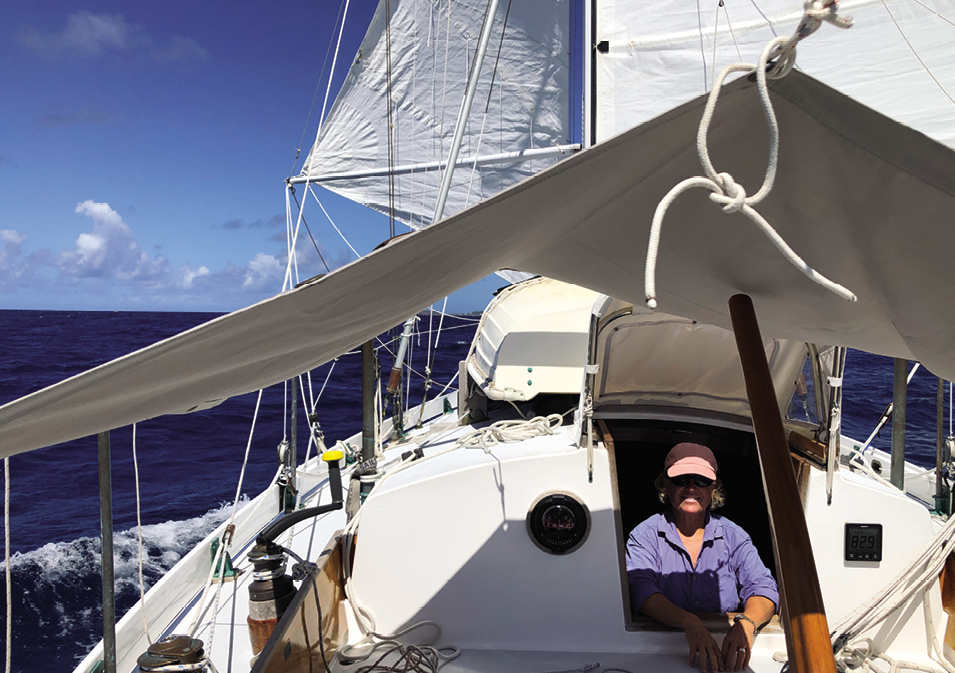
3. The smaller sea-going shade can be moved around the cockpit according the sun location.
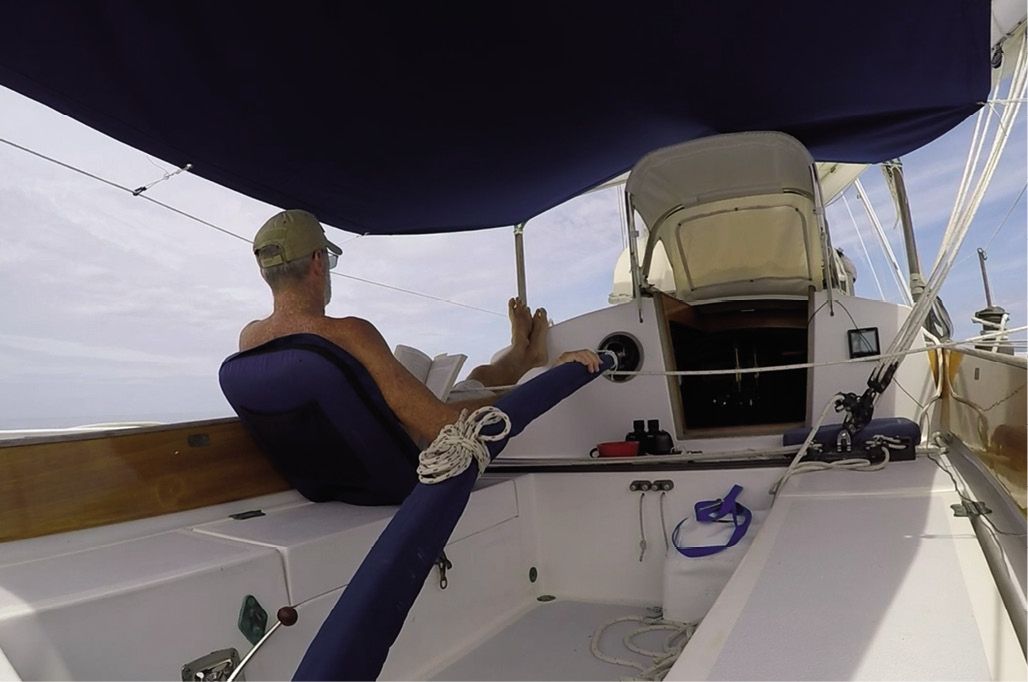
4. The trapezoidal blue cover most of the cockpit as well as the companionway. When the sun is low, heavy mesh at the sides can create additional shade.

When making a substantial investment in canvas accessories like a Bimini top or dodger, it’s easy to “go with the flow,” and accept designs that are patterned to fit contemporary cruisers that make up the larger share of the market. But owners of older “classic plastics” like the Carl Alberg designed Cape Dory 36 might want to take the time to sketch out various options first.
One of the most distinguishing characteristics of many Cruising Club of America-era boats is their low profile. While adding a relatively tall dodger that extends across the cabin top can be a practical (and expensive) addition, drawing a proportional profile view of the boat can help you decide if this is a look you can live with.
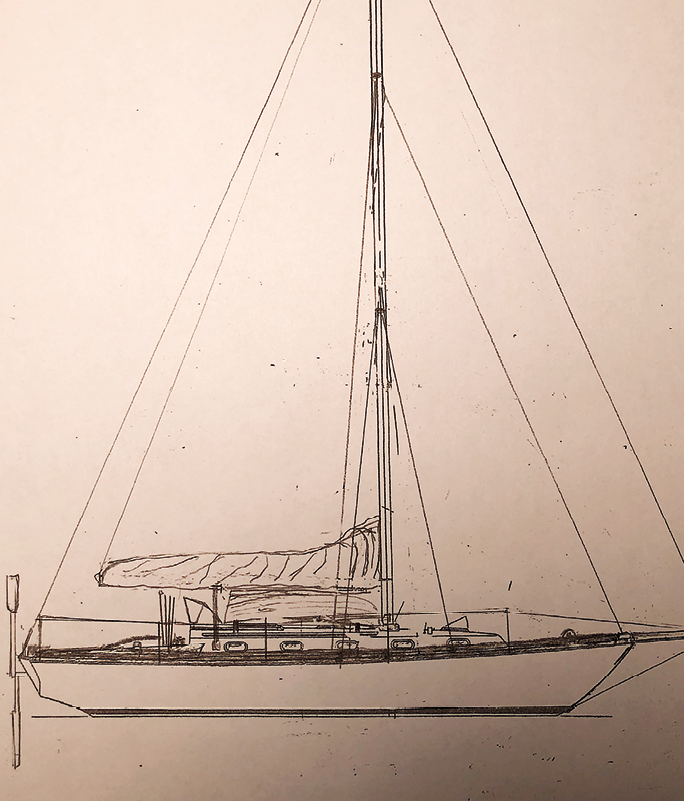
1. A tape measure, protractor, ruler, pencil and graph paper can help you pin down support measurements, panel dimensions, and window sizes that you can use to make the dodger yourself, or to guide a professional toward a perfect fit.
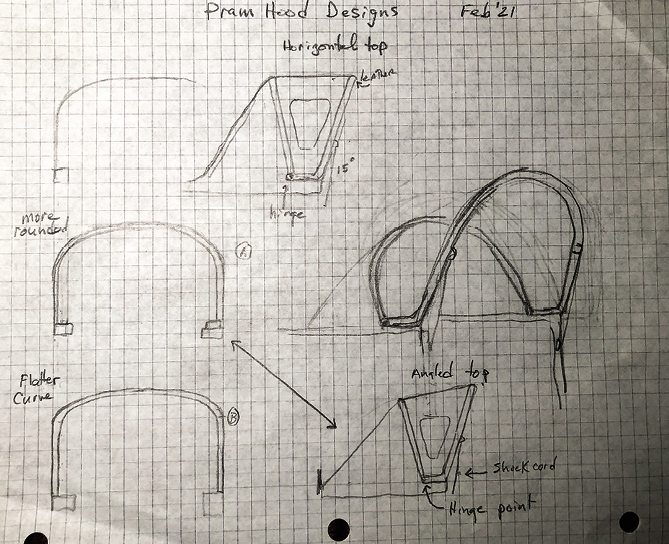
2. A profile sketch of the author’s Cape Dory 36, Far Reach, shows how the new pram-hood would appear in a profile view of the boat.
A series of sketches of the revised, second generation dodger was used to guide the final fabrication.

































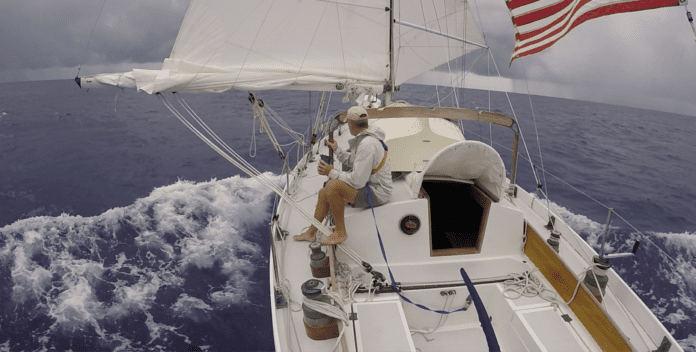





Hi John …. do you have any more photos of this design? I am interested in doing something similar.